Does Copper Have The Smae Makeup As Gold
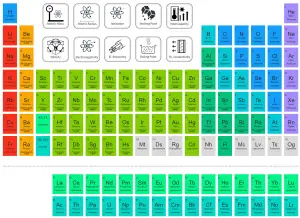
4
Exist
Beryllium
Element of group ii
12
Mg
Magnesium
Element of group i earth metal
thirteen
Al
Aluminium
Mail service-transition metals
20
Ca
Calcium
Alkali metal earth metal
21
Sc
Scandium
Transition metals
22
Ti
Titanium
Transition metals
23
V
Vanadium
Transition metals
24
Cr
Chromium
Transition metals
25
Mn
Manganese
Transition metals
31
Ga
Gallium
Postal service-transition metals
38
Sr
Strontium
Alkaline earth metals
40
Zr
Zirconium
Transition metals
42
Mo
Molybdenum
Transition metals
43
Tc
Technetium
Transition metals
44
Ru
Ruthenium
Transition metals
46
Pd
Palladium
Transition metals
49
In
Indium
Postal service-transition metals
l
Sn
Tin
Post-transition metals
73
Ta
Tantalum
Transition metals
74
W
Tungsten
Transition metals
78
Pt
Platinum
Transition metals
81
Tl
Thallium
Post-transition metals
82
Atomic number 82
Lead
Mail service-transition metals
83
Bi
Bismuth
Post-transition metals
84
Po
Polonium
Mail service-transition metals
88
Ra
Radium
Alkaline globe metal
104
Rf
Rutherfordium
Transition metal
106
Sg
Seaborgium
Transition metal
What is Copper
Copper is a chemical element with atomic number29 which means there are 29 protons and 29 electrons in the atomic construction. Thechemic symbol for Copper isCu.
Copper is a soft, malleable, and ductile metal with very high thermal and electrical conductivity. A freshly exposed surface of pure copper has a cherry-red-orange color. Copper is used equally a conductor of heat and electricity, as a building material, and as a constituent of various metal alloys, such as sterling argent used in jewelry, cupronickel used to make marine hardware and coins, and constantan used in strain gauges and thermocouples for temperature measurement.
Copper – Backdrop
| Chemical element | Copper |
|---|---|
| Atomic Number | 29 |
| Symbol | Cu |
| Chemical element Category | Transition metal |
| Phase at STP | Solid |
| Atomic Mass [amu] | 63.546 |
| Density at STP [1000/cm3] | viii.92 |
| Electron Configuration | [Ar] 3d10 4s1 |
| Possible Oxidation States | +1,two |
| Electron Analogousness [kJ/mol] | 118.4 |
| Electronegativity [Pauling scale] | ane.9 |
| 1st Ionization Energy [eV] | 7.7264 |
| Year of Discovery | unknown |
| Discoverer | unknown |
| Thermal properties | |
| Melting Point [Celsius calibration] | 1084.62 |
| Boiling Point [Celsius scale] | 2562 |
| Thermal Expansion µm/(g·K) | 16.5 |
| Thermal Electrical conductivity [W/m K] | 401 |
| Specific Heat [J/one thousand K] | 0.38 |
| Oestrus of Fusion [kJ/mol] | 13.05 |
| Oestrus of Vaporization [kJ/mol] | 300.3 |
Atomic Number of Copper
Copper is a chemical element with atomic number29 which means there are 29 protons and 29 electrons in the atomic construction. Thechemical symbol for Copper isCu.
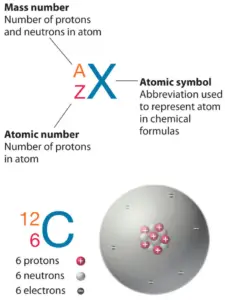 The cantlet consist of a small-scale but massivenucleus surrounded by a cloud of chop-chop movingelectrons. The nucleus is composed ofprotons and neutrons. Full number of protons in the nucleus is called theatomic number of the cantlet and is given thesymbol Z. The total electric charge of the nucleus is therefore +Ze, where e (uncomplicated accuse) equals toone,602 x 10-19 coulombs. In a neutral cantlet at that place are equally many electrons as protons moving nearly nucleus. It is the electrons that are responsible for the chemical bavavior of atoms, and which identify the various chemic elements.
The cantlet consist of a small-scale but massivenucleus surrounded by a cloud of chop-chop movingelectrons. The nucleus is composed ofprotons and neutrons. Full number of protons in the nucleus is called theatomic number of the cantlet and is given thesymbol Z. The total electric charge of the nucleus is therefore +Ze, where e (uncomplicated accuse) equals toone,602 x 10-19 coulombs. In a neutral cantlet at that place are equally many electrons as protons moving nearly nucleus. It is the electrons that are responsible for the chemical bavavior of atoms, and which identify the various chemic elements.
See as well: Atomic Number – Does it conserve in a nuclear reaction?
Diminutive Number and Chemic Properties
Every solid, liquid, gas, and plasma is composed of neutral or ionized atoms. Thechemical properties of the atom are determined past the number of protons, in fact, by number and organization of electrons. The configuration of these electrons follows from the principles of quantum mechanics. The number of electrons in each element'south electron shells, especially the outermost valence vanquish, is the primary gene in determining its chemic bonding behavior. In the periodic tabular array, the elements are listed in order of increasing atomic number Z.
It is thePauli exclusion principle that requires the electrons in an atom to occupy different energy levels instead of them all condensing in the ground state. The ordering of the electrons in the footing state of multielectron atoms, starts with the lowest free energy country (ground country) and moves progressively from there up the energy scale until each of the atom's electrons has been assigned a unique set of quantum numbers. This fact has cardinal implications for the building up of the periodic table of elements.
Neutron Number and Mass Number of Copper
Mass numbers of typical isotopes of Copper are 63; 65.
The total number of neutrons in the nucleus of an cantlet is called theneutron number of the cantlet and is given thesymbol Northward. Neutron number plus atomic number equals diminutive mass number:N+Z=A. The divergence betwixt the neutron number and the atomic number is known equally theneutron excess: D = N – Z = A – 2Z.
Neutron number is rarely written explicitly in nuclide symbol notation, merely appears as a subscript to the right of the chemical element symbol. Nuclides that accept the aforementioned neutron number just a different proton number are called isotones. The various species of atoms whose nuclei contain detail numbers of protons and neutrons are chosennuclides. Each nuclide is denoted past chemical symbol of the element (this specifies Z) with tha atomic mass number every bit supescript. Therefore, we cannot determine the neutron number of uranium, for example. We can determine the neutron number of certain isotope. For example, the neutron number of uranium-238 is 238-92=146.
Neutron and Mass Numbers and Nuclear Properties
Properties of atomic nuclei (diminutive mass, nuclear cross-sections) are determined by the number of protons and number of neutrons(neutron number). Information technology must be noted, especially nuclear cross-sections may vary by many orders from nuclide with the neutron number N to nuclide with the neutron number N+one. For case, actinides with odd neutron number are normally fissile (fissionable with tiresome neutrons) while actinides with fifty-fifty neutron number are usually non fissile (but are fissionable with fast neutrons). Heavy nuclei with an fifty-fifty number of protons and an even number of neutrons are (due to Pauli exclusion principle) very stable thanks to the occurrence of 'paired spin'. On the other hand, nuclei with an odd number of protons and neutrons are mostly unstable.
Neutron and Atomic Numbers and Nuclear Stability
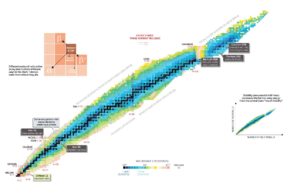
Nuclear stability is a concept that helps to identify the stability of an isotope. To identify the stability of an isotope it is needed to observe the ratio of neutrons to protons. To make up one's mind the stability of an isotope yous tin can use the ratio neutron/proton (N/Z). Also to help understand this concept there is a chart of the nuclides, known equally a Segre chart. This chart shows a plot of the known nuclides as a function of their diminutive and neutron numbers. Information technology can exist observed from the chart that there aremore neutrons than protons in nuclides withZ greater than about 20 (Calcium). Theseextra neutrons are necessary for stability of the heavier nuclei. The excess neutrons deed somewhat similar nuclear mucilage. Only 2 stable nuclides take fewer neutrons than protons: hydrogen-1 and helium-3.
Atomic nuclei consist of protons and neutrons, which attract each other throughthe nuclear force, while protons repel each other viathe electric forcefulness due to their positive accuse. These ii forces compete, leading to various stability of nuclei. There are only certain combinations of neutrons and protons, which formsstable nuclei.
Neutrons stabilize the nucleus, because they attract each other and protons , which helps beginning the electrical repulsion between protons. As a result, as the number of protons increases,an increasing ratio of neutrons to protons is needed to class a stable nucleus. If in that location are as well many or too few neutrons for a given number of protons, the resulting nucleus is non stable and it undergoes radioactive disuse.Unstable isotopesdecay through diverse radioactive decay pathways, most unremarkably blastoff decay, beta disuse, gamma decay or electron capture. Many other rare types of disuse, such every bit spontaneous fission or neutron emission are known.
Atomic Mass of Copper
Diminutive mass of Copper is 63.546 u.
The atomic mass is the mass of an atom. The atomic mass or relative isotopic mass refers to the mass of a single particle, and therefore is tied to a sure specific isotope of an element. The atomic mass is carried by the diminutive nucleus, which occupies only about 10-12of the total volume of the atom or less, but it contains all the positive charge and at least 99.95% of the total mass of the cantlet. Note that, each element may contain more isotopes, therefore this resulting diminutive mass is calculated from naturally-occuring isotopes and their abundance.
The size and mass of atoms are so small-scale that the use of normal measuring units, while possible, is oft inconvenient. Units of mensurate have been defined for mass and energy on the diminutive scale to make measurements more user-friendly to express. The unit of measurement of measure for mass is the atomic mass unit (amu). One atomic mass unit is equal to 1.66 x 10-24 grams. 1 unified atomic mass unit of measurement isapproximately the mass of one nucleon (either a unmarried proton or neutron) and is numerically equivalent to one grand/mol.
For12C the atomic mass is exactly 12u, since the diminutive mass unit is defined from it. For other isotopes, the isotopic mass unremarkably differs and is ordinarily within 0.i u of the mass number. For example, 63Cu (29 protons and 34 neutrons) has a mass number of 63 and an isotopic mass in itsnuclear ground land is 62.91367 u.
At that place are two reasons for the deviation between mass number and isotopic mass, known as the mass defect:
- Theneutron is slightly heavier than theproton. This increases the mass of nuclei with more neutrons than protons relative to the atomic mass unit calibration based on12C with equal numbers of protons and neutrons.
- The nuclear binding energy varies between nuclei. A nucleus with greater binding energy has a lower total energy, and therefore alower mass according to Einstein's mass-energy equivalence relationE =mc ii. For 63Cu the atomic mass is less than 63 and then this must be the ascendant gene.
Note that, it was found therest mass of an atomic nucleusis measurably smaller thanthe sum of the rest masses of its constituent protons, neutrons and electrons. Mass was no longer considered unchangeable in the closed system. The difference is a measure of thenuclear bounden free energy which holds the nucleus together. According to the Einstein relationship (E=mctwo), this binding energy is proportional to thismass deviation and information technology is known every bit themass defect.
See also: Atomic Mass Number – Does it conserve in a nuclear reaction?
Atomic Radius of Copper
The atomic radius of Copper atom is 132pm (covalent radius).
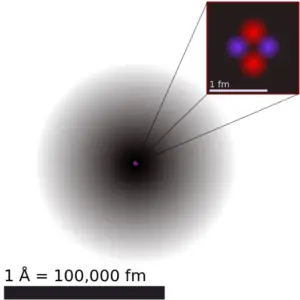
It must be noted, atoms lack a well-defined outer boundary. The atomic radius of a chemical element is a measure of the altitude out to which the electron deject extends from the nucleus. However, this assumes the cantlet to exhibit a spherical shape, which is only obeyed for atoms in vacuum or free space. Therefore, in that location are various non-equivalent definitions of atomic radius.
- Van der Waals radius.In principle, Vana der Waals radius is half the minimum distance betwixt the nuclei of two atoms of the element that are not bound to the same molecule.
- Ionic radius. An ionic radius is one-half the distance between the nuclei of two ions in an ionic bond.
- Covalent radius. Covalent radius is the nominal radius of the atoms of an element when covalently bound to other atoms.
- Metallic radius. A metal radius is one-half the distance between the nuclei of two adjacent atoms in a crystalline structure, when joined to other atoms by metal bonds.
On the periodic table of the elements, atomic radius tends to increase when moving downward columns, only subtract when moving across rows (left to right). Consequently, the smallest cantlet is helium with a radius of 32 pm, while one of the largest is caesium at 225 pm. The atomic radii decrease across the periodic table considering as the diminutive number increases, the number of protons increases across the period, but the actress electrons are simply added to the same quantum trounce. Therefore, the effective nuclear charge towards the outermost electrons increases, drawing the outermost electrons closer. As a upshot, the electron cloud contracts and the atomic radius decreases.
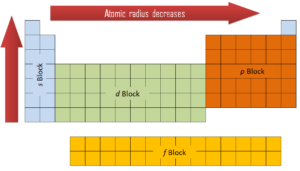 The volume of an atom is aboutfifteen orders of magnitudelargerthan the volume of a nucleus. Foruranium atom, theVan der Waals radius is about186 pm = ane.86 ×ten−tenm. The Van der Waals radius, rw, of an atom is the radius of an imaginary hard sphere representing the distance of closest arroyo for another atom. Assuming spherical shape, the uranium atom have volume of about26.9 ×10−30 miii . Only this "huge" space is occupied primarily by electrons, because thenucleus occupies only about1721×10−45 g3 of space. These electrons together weigh merely a fraction (permit say 0.05%) of entire atom.
The volume of an atom is aboutfifteen orders of magnitudelargerthan the volume of a nucleus. Foruranium atom, theVan der Waals radius is about186 pm = ane.86 ×ten−tenm. The Van der Waals radius, rw, of an atom is the radius of an imaginary hard sphere representing the distance of closest arroyo for another atom. Assuming spherical shape, the uranium atom have volume of about26.9 ×10−30 miii . Only this "huge" space is occupied primarily by electrons, because thenucleus occupies only about1721×10−45 g3 of space. These electrons together weigh merely a fraction (permit say 0.05%) of entire atom.
It may seem, that the space and in fact the matter isempty,simply information technology is not. Due to thequantum nature of electrons, the electrons are non point particles, they are smeared out over the whole cantlet. The classical description cannot be used to depict things on the atomic scale. On the atomic calibration, physicists have found that quantum mechanics describes things very well on that calibration. Particle locations in quantum mechanics are not at an exact position, they are described by aprobability density function. Therefore the space in an atom (between electrons and an atomic nucleus) is non empty, but it is filled by a probability density function of electrons (commonly known equally "electron cloud").
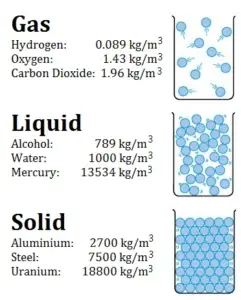 Density of Copper
Density of Copper
Density of Copper isviii.92g/cm3 .
Typical densities of diverse substances are at atmospheric pressure level.
Density is defined as themass per unit of measurement volume. It is anintensive holding, which is mathematically defined as mass divided by volume:
ρ = m/V
In words, the density (ρ) of a substance is the total mass (m) of that substance divided by the total book (V) occupied by that substance. The standard SI unit iskilograms per cubic meter (kg/chiliad3 ). The Standard English unit ispounds mass per cubic foot (lbm/ft3 ).
Density – Atomic Mass and Atomic Number Density
Since the density (ρ) of a substance is the full mass (chiliad) of that substance divided by the total volume (V) occupied by that substance, it is obvious, the density of a substance strongly depends on its atomic mass and as well on the atomic number density (N; atoms/cm3),
- Diminutive Weight. The atomic mass is carried by the diminutive nucleus, which occupies but most 10-12of the total volume of the atom or less, but information technology contains all the positive charge and at least 99.95% of the full mass of the cantlet. Therefore information technology is adamant by the mass number (number of protons and neutrons).
- Atomic Number Density. The atomic number density (N; atoms/cm3), which is associated with diminutive radii, is the number of atoms of a given type per unit volume (5; cm3) of the material. The atomic number density (Due north; atoms/cm3) of a pure material havingatomic or molecular weight (M; grams/mol) and thefabric density (⍴; gram/cm3) is easily computed from the following equation using Avogadro'due south number (NA = 6.022×ten23 atoms or molecules per mole):

Sincenucleons (protons andneutrons) make upward most of the mass of ordinary atoms, the density of normal thing tends to be express by how closely we can pack these nucleons and depends on the internal diminutive construction of a substance. Thedensest textile found on earth is themetallic osmium, but its density pales past comparison to the densities of exotic astronomical objects such as white dwarf stars andneutron stars.
If nosotros include man made elements, the densest so far is Hassium.Hassium is a chemical element with symbolHs and diminutive number 108. It is a constructed element (starting time synthesised at Hasse in Germany) and radioactive. The most stable known isotope, 269Hs, has a one-half-life of approximately 9.seven seconds. It has an estimated density of 40.7 x teniii kg/mthree . The density of Hassium results from itsloftier atomic weight and from the significant decrease inionic radii of the elements in the lanthanide serial, known every bitlanthanide and actinide contraction.
Density – Pressure and Temperature
The density of a material varies with temperature and pressure. This variation is typically small-scale for solids and liquids simply much greater for gases. Most materials aggrandize when their temperatures increment. Rise temperatures make the liquid aggrandize in a liquid-in-tube thermometer and curve bimetallic strips. As a result of this expansion, the density of about materials decreases. This consequence is caused past a subtract in the atomic number density. This dependence is usually expressed by the coefficient of linear or volume expansion.
Increasing the pressure on an cloth (especially for liquids or gases) decreases the book of the object and thus increases its density via the diminutive number density. Compressibility (besides known as the coefficient of compressibility is a measure of the relative volume change of a fluid or solid every bit a response to a pressure (or hateful stress) alter.
Encounter also: What is Density
See also: Densest Materials of the World
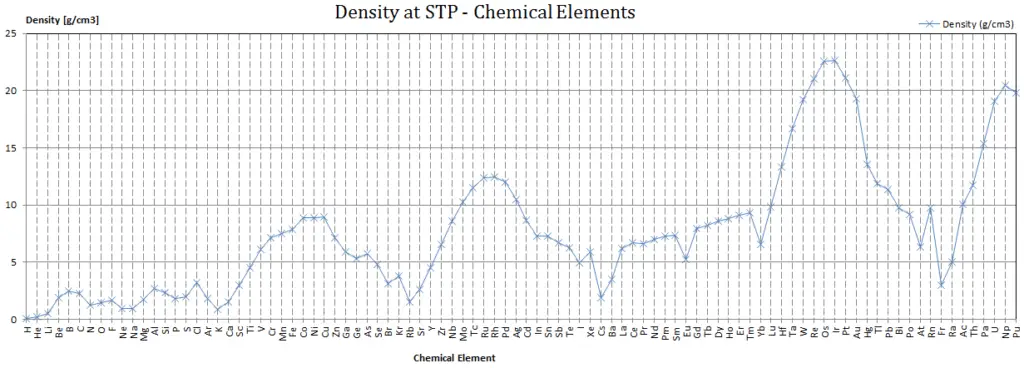
Electron Configuration and Oxidation States of Copper
Electron configuration of Copperis [Ar] 3d10 4s1.
Possible oxidation states are +ane,2.
Electron Configuration
The periodic table is a tabular display of the chemical elements organized on the footing of their diminutive numbers, electron configurations, and chemic properties. The electron configuration is the distribution of electrons of an atom or molecule (or other physical construction) in diminutive or molecular orbitals. Cognition of the electron configuration of different atoms is useful in understanding the construction of the periodic table of elements.
Every solid, liquid, gas, and plasma is composed of neutral or ionized atoms. Thechemical properties of the cantlet are determined by the number of protons, in fact, past number and arrangement of electrons. The configuration of these electrons follows from the principles of breakthrough mechanics. The number of electrons in each element's electron shells, peculiarly the outermost valence shell, is the main cistron in determining its chemical bonding behavior. In the periodic table, the elements are listed in gild of increasing atomic number Z.
It is thePauli exclusion principle that requires the electrons in an atom to occupy dissimilar free energy levels instead of them all condensing in the ground state. The ordering of the electrons in the ground state of multielectron atoms, starts with the lowest energy land (ground state) and moves progressively from there up the energy scale until each of the atom'southward electrons has been assigned a unique gear up of quantum numbers. This fact has key implications for the building up of the periodic table of elements.
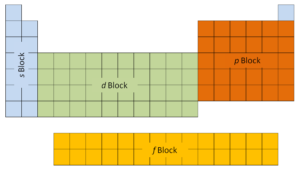 The outset two columns on the left side of the periodic table are where thes subshells are being occupied. Because of this, the showtime two rows of the periodic table are labeled thes cake. Similarly, thep blockare the correct-most six columns of the periodic tabular array, thed blockis the heart 10 columns of the periodic table, while thef blockis the fourteen-column section that is ordinarily depicted as detached from the principal body of the periodic table. Information technology could be function of the main body, only then the periodic table would be rather long and cumbersome.
The outset two columns on the left side of the periodic table are where thes subshells are being occupied. Because of this, the showtime two rows of the periodic table are labeled thes cake. Similarly, thep blockare the correct-most six columns of the periodic tabular array, thed blockis the heart 10 columns of the periodic table, while thef blockis the fourteen-column section that is ordinarily depicted as detached from the principal body of the periodic table. Information technology could be function of the main body, only then the periodic table would be rather long and cumbersome.
For atoms with many electrons, this notation tin can become lengthy and so an abbreviated notation is used. The electron configuration can be visualized as the core electrons, equivalent to the element of group 0 of the preceding catamenia, and the valence electrons (e.g. [Xe] 6s2 for barium).
Oxidation States
Oxidation states are typically represented by integers which may be positive, zero, or negative. Almost elements have more than one possible oxidation state. For example, carbon has nine possible integer oxidation states from −iv to +iv.
The electric current IUPAC Gold Book definition of oxidation country is:
"Oxidation state of an atom is the charge of this atom after ionic approximation of its heteronuclear bonds…"
and the term oxidation number is almost synonymous. An element that is not combined with whatever other different elements has an oxidation country of 0. Oxidation state 0 occurs for all elements – it is simply the element in its elemental form. An cantlet of an element in a compound will take a positive oxidation state if it has had electrons removed. Similarly, calculation electrons results in a negative oxidation state. Nosotros have also distinguish between the possible and mutual oxidation states of every element. For case, silicon has ix possible integer oxidation states from −4 to +four, but just -4, 0 and +iv are common oxidation states.
Electron Affinity and Electronegativity of Copper
Electron affinity of Copper is 118.4 kJ/mol.
Electronegativity of Copper is1.9.
Electron Affinity
In chemistry and atomic physics, theelectron affinity of an atom or molecule is defined as:
the modify in energy (in kJ/mole) of a neutral atom or molecule (in the gaseous phase) when an electron is added to the cantlet to form a negative ion.
X + eastward– → X– + energy Analogousness = – ∆H
In other words, it can be expressed every bit the neutral cantlet'slikelihood of gaining an electron. Note that, ionization energies measure out the trend of a neutral atom to resist the loss of electrons. Electron affinities are more hard to measure than ionization energies.
An cantlet of Copper in the gas phase, for case, gives off free energy when it gains an electron to form an ion of Copper.
Cu + east– → Cu– – ∆H = Affinity = 118.four kJ/mol
To use electron affinities properly, information technology is essential to go along track of sign. When an electron is added to a neutral atom, energy is released. This affinity is known every bit the showtime electron analogousness and these energies are negative. By convention, the negative sign shows a release of energy. However, more than free energy is required to add an electron to a negative ion which overwhelms whatsoever the release of energy from the electron attachment process. This affinity is known as the 2nd electron affinity and these energies are positive.
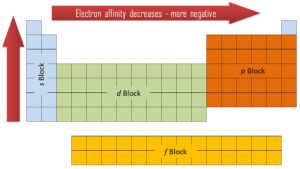 Electron affinity can be either positive or negative value. The greater the negative value, the more stable the anion is. Although affinity varies profoundly beyond the periodic table, some patterns sally. Generally, the elements on the right side of the periodic table will take large negative electron affinity. The electron affinities will go less negative equally you go from the top to the bottom of the periodic tabular array. However, nitrogen, oxygen, and fluorine practise non follow this trend. Moreover, nonmetals take more than positive analogousness than metals. Atoms whose anions are more stable than neutral atoms take a greater affinity. Chlorine about strongly attracts extra electrons, while neon well-nigh weakly attracts an extra electron.
Electron affinity can be either positive or negative value. The greater the negative value, the more stable the anion is. Although affinity varies profoundly beyond the periodic table, some patterns sally. Generally, the elements on the right side of the periodic table will take large negative electron affinity. The electron affinities will go less negative equally you go from the top to the bottom of the periodic tabular array. However, nitrogen, oxygen, and fluorine practise non follow this trend. Moreover, nonmetals take more than positive analogousness than metals. Atoms whose anions are more stable than neutral atoms take a greater affinity. Chlorine about strongly attracts extra electrons, while neon well-nigh weakly attracts an extra electron.
Affinities of Non metals vs. Affinities of Metals
- Metals: Metals similar to lose valence electrons to form cations to have a fully stable shell. The electron analogousness of metals is lower than that of nonmetals. Mercury most weakly attracts an extra electron.
- Nonmetals: Generally, nonmetals take more than positive electron affinity than metals. Nonmetals like to gain electrons to form anions to take a fully stable electron shell. Chlorine nearly strongly attracts extra electrons. The electron affinities of the noble gases accept non been conclusively measured, then they may or may not have slightly negative values.
Electronegativity
Electronegativity, symbol χ, is a chemical property that describes the tendency of an cantlet to attract electrons towards this cantlet. For this purposes, adimensionless quantity thePauling scale, symbol χ, is the nigh usually used.
The electronegativity of Copper is: χ = one.9
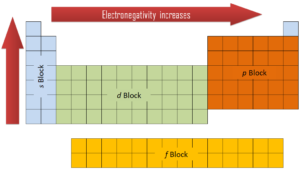 In general, an atom's electronegativity is afflicted past both its diminutive number and the distance at which its valence electrons reside from the charged nucleus. The college the associated electronegativity number, the more an element or compound attracts electrons towards it. The most electronegative atom, fluorine, is assigned a value of 4.0, and values range down to cesium and francium which are the to the lowest degree electronegative at 0.7. Electronegativity is related with ionization energy and electron affinity. Electrons with low ionization energies accept low electronegativities because their nuclei do non exert a strong bonny force on electrons. Elements with loftier ionization energies have high electronegativities due to the strong pull exerted by the positive nucleus on the negative electrons. Therefore the electronegativity is greatest at the top-right of the periodic table and decreases toward the bottom-left.
In general, an atom's electronegativity is afflicted past both its diminutive number and the distance at which its valence electrons reside from the charged nucleus. The college the associated electronegativity number, the more an element or compound attracts electrons towards it. The most electronegative atom, fluorine, is assigned a value of 4.0, and values range down to cesium and francium which are the to the lowest degree electronegative at 0.7. Electronegativity is related with ionization energy and electron affinity. Electrons with low ionization energies accept low electronegativities because their nuclei do non exert a strong bonny force on electrons. Elements with loftier ionization energies have high electronegativities due to the strong pull exerted by the positive nucleus on the negative electrons. Therefore the electronegativity is greatest at the top-right of the periodic table and decreases toward the bottom-left.
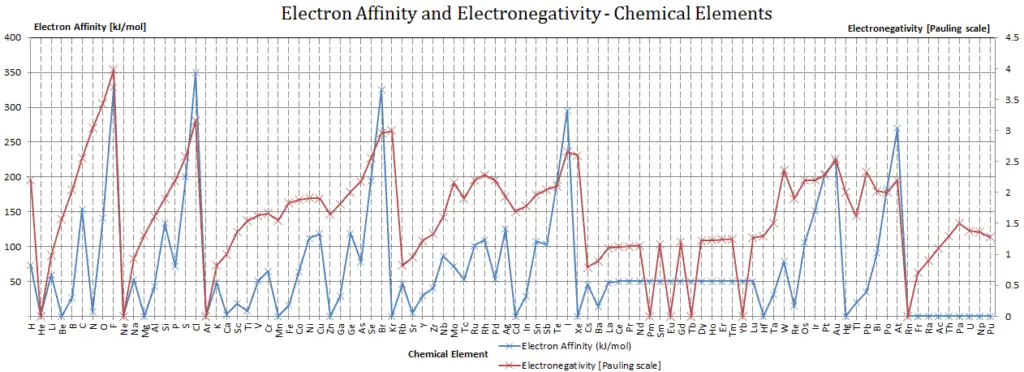
First Ionization Energy of Copper
First Ionization Energy of Copper is seven.7264 eV.
Ionization energy, too called ionization potential, is the energy necessary to remove an electron from the neutral atom.
X + energy → X+ + e−
where X is whatsoever atom or molecule capable of being ionized, X+ is that cantlet or molecule with an electron removed (positive ion), and e− is the removed electron.
A Copper atom, for example, requires the post-obit ionization free energy to remove the outermost electron.
Cu + IE → Cu+ + e− IE = vii.7264 eV
The ionization energy associated with removal of the starting time electron is virtually commonly used. Thenthursday ionization energy refers to the amount of free energy required to remove an electron from the species with a accuse of (north-i).
1st ionization energy
X → X+ + due east−
2nd ionization energy
10+ → 102+ + due east−
3rd ionization energy
Xtwo+ → X3+ + e−
Ionization Energy for different Elements
At that place is an ionization free energy for each successive electron removed. The electrons that circle the nucleus move in adequately well-defined orbits. Some of these electrons are more tightly jump in the atom than others. For example, only 7.38 eV is required to remove the outermost electron from a pb atom, while 88,000 eV is required to remove the innermost electron. Helps to empathise reactivity of elements (especially metals, which lose electrons).
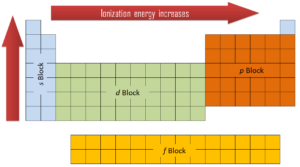 In general, the ionization energy increases moving up a group and moving left to right beyond a menstruum. Ionization energy is is related with electronegativity and electron affinity. Electrons with low ionization energies have low electronegativities considering their nuclei do not exert a potent attractive force on electrons. Elements with loftier ionization energies take loftier electronegativities due to the strong pull exerted by the positive nucleus on the negative electrons. Therefore the electronegativity is greatest at the top-right of the periodic table and decreases toward the bottom-left. Moreover:
In general, the ionization energy increases moving up a group and moving left to right beyond a menstruum. Ionization energy is is related with electronegativity and electron affinity. Electrons with low ionization energies have low electronegativities considering their nuclei do not exert a potent attractive force on electrons. Elements with loftier ionization energies take loftier electronegativities due to the strong pull exerted by the positive nucleus on the negative electrons. Therefore the electronegativity is greatest at the top-right of the periodic table and decreases toward the bottom-left. Moreover:
- Ionization energy is lowest for the alkali metals which have a unmarried electron exterior a closed shell.
- Ionization energy increases across a row on the periodic maximum for the noble gases which have airtight shells.
For case, sodium requires only 496 kJ/mol or 5.14 eV/atom to ionize it. On the other hand neon, the noble gas, immediately preceding information technology in the periodic table, requires 2081 kJ/mol or 21.56 eV/atom.
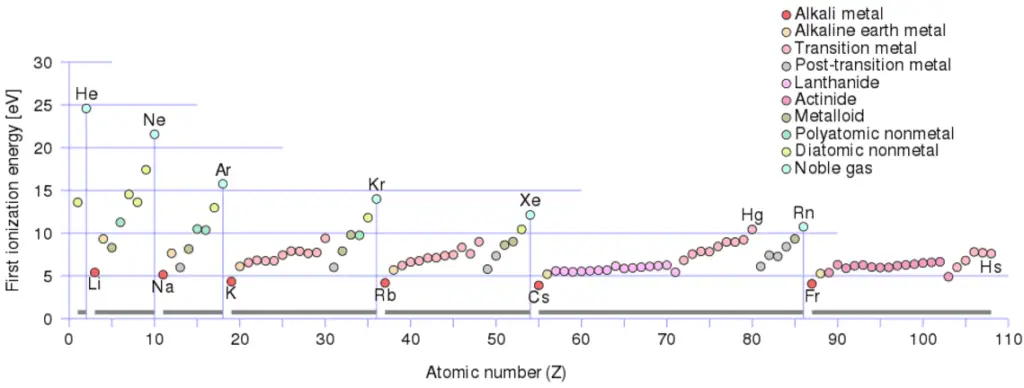
Copper – Melting Point and Boiling Point
Melting betoken of Copper is 1084.62°C.
Humid betoken of Copper is 2562°C.
Note that, these points are associated with the standard atmospheric pressure.
Boiling Signal
In full general, boiling is a stage modify of a substance from the liquid to the gas stage. The boiling point of a substance is the temperature at which this phase change (boiling or vaporization) occurs. The temperature at which vaporization (boiling) starts to occur for a given pressure is also known as the saturation temperature and at this conditions a mixture of vapor and liquid can be together. The liquid can exist said to be saturated with thermal energy. Any addition of thermal energy results in a phase transition. At the boiling point the two phases of a substance, liquid and vapor, have identical free energies and therefore are equally likely to exist. Below the boiling point, the liquid is the more stable state of the two, whereas above the gaseous grade is preferred. The pressure at which vaporization (humid) starts to occur for a given temperature is chosen the saturation pressure level. When considered equally the temperature of the opposite modify from vapor to liquid, it is referred to as the condensation indicate.
As tin be seen, the boiling point of a liquid varies depending upon the surrounding environmental force per unit area. A liquid in a partial vacuum has a lower boiling point than when that liquid is at atmospheric pressure. A liquid at high force per unit area has a higher humid indicate than when that liquid is at atmospheric pressure level. For example, water boils at 100°C (212°F) at sea level, just at 93.4°C (200.one°F) at 1900 metres (half-dozen,233 ft) altitude. On the other hand, water boils at 350°C (662°F) at sixteen.5 MPa (typical pressure of PWRs).
In the periodic table of elements, the element with the everyman humid signal is helium. Both the boiling points of rhenium and tungsten exceed 5000 1000 at standard pressure level. Since it is difficult to measure out extreme temperatures precisely without bias, both have been cited in the literature as having the higher boiling signal.
Melting Point
In general, melting is a phase change of a substance from the solid to the liquid stage. The melting betoken of a substance is the temperature at which this phase alter occurs. The melting point besides defines a status in which the solid and liquid tin exist in equilibrium. Adding a estrus will convert the solid into a liquid with no temperature change. At the melting point the ii phases of a substance, liquid and vapor, accept identical free energies and therefore are equally likely to exist. Beneath the melting point, the solid is the more than stable state of the two, whereas to a higher place the liquid grade is preferred. The melting signal of a substance depends on pressure and is usually specified at standard pressure level. When considered equally the temperature of the reverse alter from liquid to solid, it is referred to as the freezing indicate or crystallization signal.
Run across likewise: Melting Point Depression
The kickoff theory explaining mechanism of melting in the bulk was proposed past Lindemann, who used vibration of atoms in the crystal to explain the melting transition. Solids are similar to liquids in that both are condensed states, with particles that are far closer together than those of a gas. The atoms in a solid are tightly bound to each other, either in a regular geometric lattice (crystalline solids, which include metals and ordinary ice) or irregularly (an amorphous solid such as common window drinking glass), and are typically depression in free energy. The motion of individual atoms, ions, or molecules in a solid is restricted to vibrational motion nearly a stock-still indicate. Equally a solid is heated, its particles vibrate more quickly as the solid absorbs kinetic energy. At some bespeak the amplitude of vibration becomes so large that the atoms start to invade the infinite of their nearest neighbors and disturb them and the melting process initiates. The melting point is the temperature at which the disruptive vibrations of the particles of the solid overcome the attractive forces operating within the solid.
Every bit with boiling points, the melting indicate of a solid is dependent on the strength of those attractive forces. For instance, sodium chloride (NaCl) is an ionic compound that consists of a multitude of stiff ionic bonds. Sodium chloride melts at 801°C. On the other paw, ice (solid HiiO) is a molecular compound whose molecules are held together by hydrogen bonds, which is effectively a strong example of an interaction between two permanent dipoles. Though hydrogen bonds are the strongest of the intermolecular forces, the strength of hydrogen bonds is much less than that of ionic bonds. The melting betoken of ice is 0 °C.
Covalent bonds ofttimes result in the germination of small collections of better-connected atoms called molecules, which in solids and liquids are bound to other molecules by forces that are often much weaker than the covalent bonds that hold the molecules internally together. Such weak intermolecular bonds requite organic molecular substances, such equally waxes and oils, their soft bulk character, and their depression melting points (in liquids, molecules must cease near structured or oriented contact with each other).
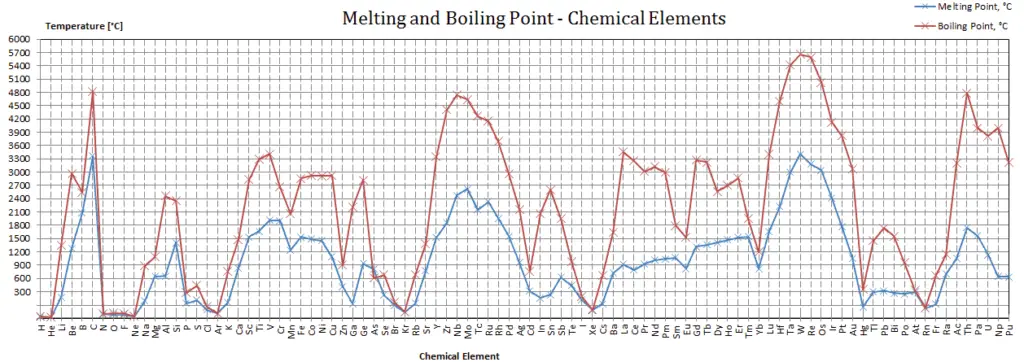
Copper – Thermal Conductivity
Thermal conductivity of Copper is 401 W/(m·K).
The heat transfer characteristics of a solid material are measured by a property called the thermal conductivity, one thousand (or λ), measured in Due west/m.K. It is a measure of a substance's ability to transfer heat through a material by conduction. Note that Fourier'south law applies for all affair, regardless of its country (solid, liquid, or gas), therefore, it is also defined for liquids and gases.
The thermal electrical conductivity of most liquids and solids varies with temperature. For vapors, it also depends upon pressure. In general:

Most materials are very nearly homogeneous, therefore nosotros tin can usually write chiliad = chiliad (T) . Similar definitions are associated with thermal conductivities in the y- and z-directions (ky, kz), simply for an isotropic material the thermal electrical conductivity is independent of the direction of transfer, kx = ky = kz = k.
Thermal Electrical conductivity of Metals
Transport of thermal free energy in solids may be generally due to two furnishings:
- the migration of free electrons
- lattice vibrational waves (phonons)
When electrons and phonons carry thermal free energy leading to conduction heat transfer in a solid, the thermal electrical conductivity may be expressed every bit:
k = keast + kph
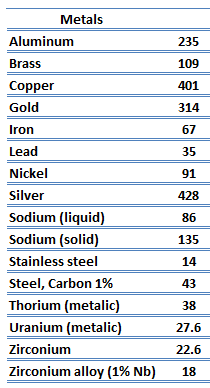 Metals are solids and as such they possess crystalline structure where the ions (nuclei with their surrounding shells of core electrons) occupy translationally equivalent positions in the crystal lattice.Metals in full general haveloftier electrical electrical conductivity,high thermal conductivity, and high density. Appropriately, transport of thermal free energy may be due to two furnishings:
Metals are solids and as such they possess crystalline structure where the ions (nuclei with their surrounding shells of core electrons) occupy translationally equivalent positions in the crystal lattice.Metals in full general haveloftier electrical electrical conductivity,high thermal conductivity, and high density. Appropriately, transport of thermal free energy may be due to two furnishings:
- the migration offree electrons
- lattice vibrational waves (phonons).
When electrons and phonons comport thermal energy leading to conduction oestrus transfer in a solid, the thermal conductivity may exist expressed equally:
k = kdue east + kph
The unique feature of metals as far as their structure is concerned is the presence of accuse carriers, specificallyelectrons. The electrical and thermal conductivities of metalsoriginate from the fact that theirouter electrons are delocalized. Their contribution to the thermal conductivity is referred to every bit theelectronic thermal conductivity, k e . In fact, in pure metals such as gold, silverish, copper, and aluminum, the rut electric current associated with the flow of electrons by far exceeds a small contribution due to the flow of phonons. In contrast, for alloys, the contribution of thouph to k is no longer negligible.
Thermal Electrical conductivity of Nonmetals
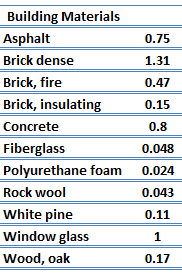 For nonmetallic solids,k is determined primarily byk ph , which increases as the frequency of interactions between the atoms and the lattice decreases. In fact, lattice thermal conduction is the ascendant thermal conduction mechanism in nonmetals, if non the only i. In solids, atoms vibrate about their equilibrium positions (crystal lattice). The vibrations of atoms are not independent of each other, just are rather strongly coupled with neighboring atoms. The regularity of the lattice arrangement has an important effect onone thousand ph , with crystalline (well-ordered) materials likequartz having a college thermal electrical conductivity than baggy materials similar glass. At sufficiently loftier temperatures kph ∝ i/T.
For nonmetallic solids,k is determined primarily byk ph , which increases as the frequency of interactions between the atoms and the lattice decreases. In fact, lattice thermal conduction is the ascendant thermal conduction mechanism in nonmetals, if non the only i. In solids, atoms vibrate about their equilibrium positions (crystal lattice). The vibrations of atoms are not independent of each other, just are rather strongly coupled with neighboring atoms. The regularity of the lattice arrangement has an important effect onone thousand ph , with crystalline (well-ordered) materials likequartz having a college thermal electrical conductivity than baggy materials similar glass. At sufficiently loftier temperatures kph ∝ i/T.
Thequanta of the crystal vibrational field are referred to every bit ''phonons.'' A phonon is a commonage excitation in a periodic, elastic arrangement of atoms or molecules in condensed affair, like solids and some liquids. Phonons play a major part in many of the physical properties of condensed thing, like thermal conductivity and electrical electrical conductivity. In fact, for crystalline, nonmetallic solids such as diamond, kph tin be quite big, exceeding values of 1000 associated with good conductors, such every bit aluminum. In particular, diamond has the highest hardness and thermal conductivity (k = 1000 W/m.K) of any bulk fabric.
Thermal Conductivity of Liquids and Gases
In physics, a fluid is a substance that continually deforms (flows) under an applied shear stress.Fluids are a subset of the phases of matter and includeliquids,gases, plasmas and, to some extent, plastic solids. Because the intermolecular spacing is much larger and the motion of the molecules is more random for the fluid state than for the solid country,thermal energy send is less effective. Thethermal conductivity of gases and liquids is therefore by and large smaller than that of solids. In liquids, the thermal conduction is caused by atomic or molecular improvidence. In gases, the thermal conduction is acquired by improvidence of molecules from higher energy level to the lower level.
Thermal Conductivity of Gases
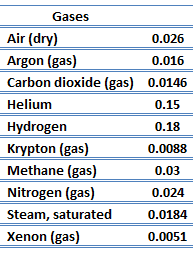 The upshot of temperature, pressure, and chemical species on the thermal conductivity of a gas may be explained in terms of thekinetic theory of gases. Air and other gases are generally good insulators, in the absenteeism of convection. Therefore, many insulating materials (east.g.polystyrene) office simply by having a large number ofgas-filled pockets whichpreclude big-scale convection. Alternation of gas pocket and solid fabric causes that the rut must be transferred through many interfaces causing rapid decrease in heat transfer coefficient.
The upshot of temperature, pressure, and chemical species on the thermal conductivity of a gas may be explained in terms of thekinetic theory of gases. Air and other gases are generally good insulators, in the absenteeism of convection. Therefore, many insulating materials (east.g.polystyrene) office simply by having a large number ofgas-filled pockets whichpreclude big-scale convection. Alternation of gas pocket and solid fabric causes that the rut must be transferred through many interfaces causing rapid decrease in heat transfer coefficient.
Thethermal electrical conductivity of gases is directly proportional to the density of the gas, the mean molecular speed, and especially to themean free path of molecule. The hateful complimentary path also depends on the bore of the molecule, with larger molecules more likely to experience collisions than small-scale molecules, which is the average distance traveled by an energy carrier (a molecule) before experiencing a collision. Low-cal gases, such ashydrogen andhelium typically havehigh thermal conductivity. Dumbo gases such as xenon and dichlorodifluoromethane have low thermal conductivity.
In full general, the thermal conductivity of gases increases with increasing temperature.
Thermal Conductivity of Liquids
As was written, in liquids, the thermal conduction is caused by atomic or molecular diffusion, merely physical mechanisms for explaining the thermal conductivity of liquids are not well understood. Liquids tend to have better thermal conductivity than gases, and the power to period makes a liquid suitable for removing backlog heat from mechanical components. The heat tin can be removed by channeling the liquid through a estrus exchanger. The coolants used in nuclear reactors include h2o or liquid metals, such every bit sodium or atomic number 82.
The thermal conductivity of nonmetallic liquids generally decreases with increasing temperature.
Coefficient of Thermal Expansion of Copper
Linear thermal expansion coefficient of Copper is sixteen.5 µm/(m·G)
Thermal expansion is generally the trend of matter to change its dimensions in response to a change in temperature. Information technology is usually expressed as a fractional change in length or volume per unit temperature alter. Thermal expansion is common for solids, liquids and for gases. Unlike gases or liquids, solid materials tend to keep their shape when undergoing thermal expansion. A linear expansion coefficient is ordinarily employed in describing the expansion of a solid, while a book expansion coefficient is more useful for a liquid or a gas.
The linear thermal expansion coefficient is defined as:

where L is a item length measurement and dL/dT is the charge per unit of change of that linear dimension per unit modify in temperature.
The volumetric thermal expansion coefficient is the almost basic thermal expansion coefficient, and the near relevant for fluids. In general, substances expand or contract when their temperature changes, with expansion or contraction occurring in all directions.
The volumetric thermal expansion coefficient is defined as:

where L is the volume of the material and dV/dT is the rate of change of that volume per unit change in temperature.
In a solid or liquid, there is a dynamic residue between the cohesive forces holding the atoms or molecules together and the conditions created past temperature. Therefore college temperatures imply greater distance between atoms. Different materials have unlike bonding forces and therefore different expansion coefficients. If a crystalline solid is isometric (has the same structural configuration throughout), the expansion volition be uniform in all dimensions of the crystal. For these materials, the area and volumetric thermal expansion coefficient are, respectively, approximately twice and three times larger than the linear thermal expansion coefficient (αV = 3αFifty ). If it is not isometric, at that place may be different expansion coefficients for different crystallographic directions, and the crystal will change shape as the temperature changes.
Copper – Specific Oestrus, Latent Heat of Fusion, Latent Oestrus of Vaporization
Specific oestrus of Copper is 0.38 J/1000 K.
Latent Heat of Fusion of Copper is 13.05 kJ/mol.
Latent Heat of Vaporization of Copper is 300.three kJ/mol.
Specific Oestrus
Specific estrus, or specific heat capacity,is a property related to internal energy that is very important in thermodynamics. Theintensive propertiesc5 and cp are divers for pure, simple compressible substances as fractional derivatives of theinternal energyu(T, v) andenthalpyh(T, p) , respectively:
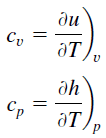
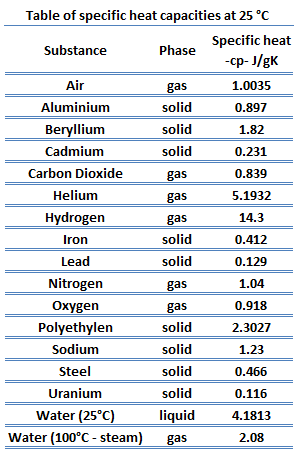 where the subscriptsv andp announce the variables held fixed during differentiation. The propertiescvandcp are referred to equallyspecific heats(orheat capacities) because under certain special conditions they relate the temperature alter of a system to the amount of energy added past oestrus transfer. Their SI units areJ/kg K orJ/mol Chiliad.
where the subscriptsv andp announce the variables held fixed during differentiation. The propertiescvandcp are referred to equallyspecific heats(orheat capacities) because under certain special conditions they relate the temperature alter of a system to the amount of energy added past oestrus transfer. Their SI units areJ/kg K orJ/mol Chiliad.
Different substancesare afflicted tounlike magnitudespast theimprover of oestrus. When a given amount of estrus is added to different substances, their temperatures increase by different amounts.
Rut capacity is an extensive belongings of matter, meaning it is proportional to the size of the arrangement.Heat capacity C has the unit of measurement of free energy per caste or energy per kelvin. When expressing the same phenomenon equally an intensive property, theheat chapters is divided past the corporeality of substance, mass, or book, thus the quantity is independent of the size or extent of the sample.
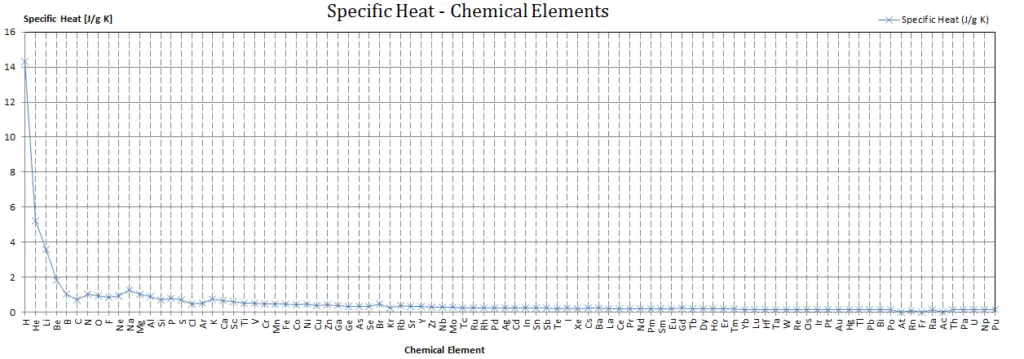
Latent Heat of Vaporization
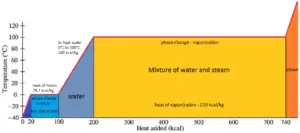 In general, when a materialchanges phase from solid to liquid, or from liquid to gas a certain amount of energy is involved in this change of phase. In instance of liquid to gas stage change, this corporeality of energy is known equally theenthalpy of vaporization, (symbol ∆Hvap; unit: J) also known as the(latent) heat of vaporization or heat of evaporation. Equally an case, come across the figure, which descibes stage transitions of water.
In general, when a materialchanges phase from solid to liquid, or from liquid to gas a certain amount of energy is involved in this change of phase. In instance of liquid to gas stage change, this corporeality of energy is known equally theenthalpy of vaporization, (symbol ∆Hvap; unit: J) also known as the(latent) heat of vaporization or heat of evaporation. Equally an case, come across the figure, which descibes stage transitions of water.
Latent oestrus is the amount of heat added to or removed from a substance to produce a change in phase. This energy breaks down the intermolecular attractive forces, and as well must provide the free energy necessary to expand the gas (thepΔV work). When latent heat is added, no temperature alter occurs. The enthalpy of vaporization is a function of the pressure at which that transformation takes place.
The temperature at which vaporization (boiling) starts to occur for a given pressure level is also known every bit the saturation temperature and at this weather condition a mixture of vapor and liquid tin exist together. The liquid can be said to exist saturated with thermal free energy. Any improver of thermal energy results in a phase transition. At the boiling point the two phases of a substance, liquid and vapor, have identical free energies and therefore are equally likely to be. Below the boiling point, the liquid is the more stable state of the two, whereas above the gaseous form is preferred.
Latent Rut of Fusion
In example of solid to liquid stage change, the change in enthalpy required to change its state is known every bit the enthalpy of fusion, (symbol ∆Hfus; unit of measurement: J) besides known as the(latent) heat of fusion. Latent heat is the amount of estrus added to or removed from a substance to produce a modify in phase. This energy breaks down the intermolecular attractive forces, and likewise must provide the energy necessary to expand the organisation (thepΔV work).
The liquid phase has a higher internal energy than the solid stage. This means energy must be supplied to a solid in lodge to melt information technology and energy is released from a liquid when it freezes, because the molecules in the liquid experience weaker intermolecular forces and and so take a higher potential energy (a kind of bail-dissociation free energy for intermolecular forces).
The temperature at which the stage transition occurs is the melting betoken. The melting point also defines a status in which the solid and liquid can exist in equilibrium. Adding a heat will convert the solid into a liquid with no temperature change. At the melting point the two phases of a substance, liquid and vapor, have identical gratis energies and therefore are equally likely to be. Below the melting point, the solid is the more stable state of the two, whereas above the liquid course is preferred. The melting point of a substance depends on pressure and is usually specified at standard pressure level. When considered every bit the temperature of the opposite modify from liquid to solid, information technology is referred to every bit the freezing point or crystallization indicate.
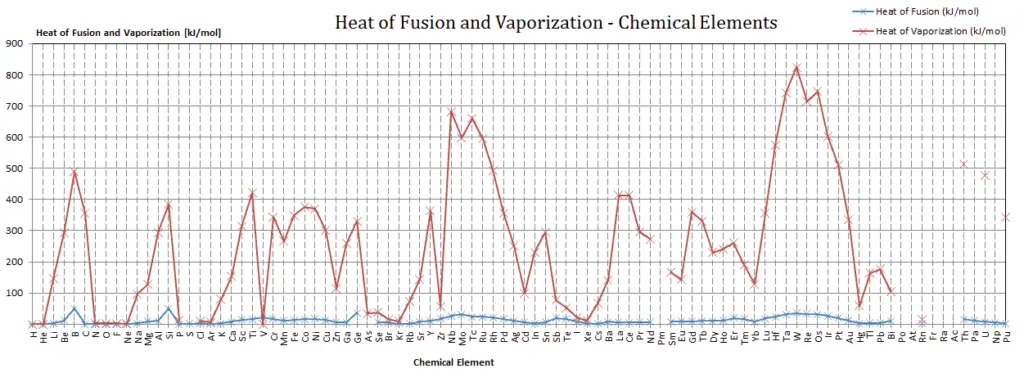
Copper – Electrical Resistivity and Electrical Conductivity
Electric resistivity of Copper is 16.8 nΩ·m.
Electrical resistivity and its converse, electrical electrical conductivity, is a cardinal belongings of a material that quantifies how strongly it resists or conducts the flow of electrical current. A low resistivity indicates a cloth that readily allows the menstruation of electric electric current. The symbol of resistivity is usually the Greek letter ρ (rho). The SI unit of measurement of electrical resistivity is the ohm-metre (Ω⋅m). Note that, electrical resistivity is not the same as electrical resistance. Electrical resistance is expressed in Ohms. While resistivity is a material holding, resistance is the property of an object.
Conductors – Semiconductors – Resistors
Substances in which electricity tin flow are called conductors. Conductors are made of loftier-conductivity materials such as metals, in particular copper and aluminium.
Insulators, on the other hand, are made of a wide variety of materials depending on factors such every bit the desired resistance.
Semiconductors are materials, inorganic or organic, which have the ability to control their conduction depending on chemical structure, temperature, illumination, and presence of dopants. The name semiconductor comes from the fact that these materials have an electrical electrical conductivity between that of a metal, like copper, aureate, etc. and an insulator, such equally glass. They take an free energy gap less than 4eV (well-nigh 1eV). In solid-state physics, this energy gap or band gap is an energy range betwixt valence ring and conduction band where electron states are forbidden. In contrast to conductors, electrons in a semiconductor must obtain free energy (e.thousand. from ionizing radiation) to cross the band gap and to achieve the conduction ring.
To understand the difference betweenmetals,semiconductors andelectrical insulators, we take to define the following terms from solid-state physics:
-
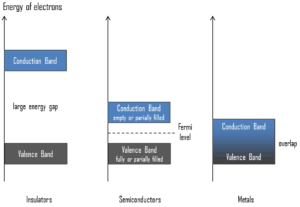 Valence Band. In solid-state physics, thevalence band andconduction band are the bands closest to theFermi level and thus determine the electrical conductivity of the solid. In electrical insulators and semiconductors, the valence ring is the highest range of electron energies in which electrons are normally present at absolute cypher temperature. For instance, asilicon atom has 14 electrons. In the ground land, they are arranged in the electron configuration[Ne]3s23p2 . Of these,four are valence electrons, occupying the 3s orbital and two of the 3p orbitals. The stardom between the valence and conduction bands is meaningless in metals, considering conduction occurs in i or more partially filled bands that take on the properties of both the valence and conduction bands.
Valence Band. In solid-state physics, thevalence band andconduction band are the bands closest to theFermi level and thus determine the electrical conductivity of the solid. In electrical insulators and semiconductors, the valence ring is the highest range of electron energies in which electrons are normally present at absolute cypher temperature. For instance, asilicon atom has 14 electrons. In the ground land, they are arranged in the electron configuration[Ne]3s23p2 . Of these,four are valence electrons, occupying the 3s orbital and two of the 3p orbitals. The stardom between the valence and conduction bands is meaningless in metals, considering conduction occurs in i or more partially filled bands that take on the properties of both the valence and conduction bands. - Conduction Band. In solid-state physics, the valence band and conduction ring are the bands closest to the Fermi level and thus determine the electric conductivity of the solid. In electrical insulators and semiconductors, theconduction band is the lowest range ofvacant electronic states. On a graph of the electronic band structure of a cloth, the valence band is located below the Fermi level, while theconduction ring is located above it. In semiconductors, electrons may achieve the conduction band, when they areexcited, for instance, by ionizing radiation (i.e. they must obtain free energy college thanEgap ). For example, diamond is a wide-band gap semiconductor (Eastgap= v.47 eV) with loftier potential equally an electronic device material in many devices. On the other side, germanium has a modest band gap free energy (Eastgap = 0.67 eV), which requires to operate the detector at cryogenic temperatures. The distinction between the valence and conduction bands is meaningless in metals, considering conduction occurs in ane or more than partially filled bands that have on the properties of both the valence and conduction bands.
- Ring Gap. In solid-country physics, theenergy gap or thering gap is an energy range between valence ring and conduction ring where electron states are forbidden. In contrast to conductors, electrons in a semiconductor must obtain energy (e.one thousand. from ionizing radiation) to cross the ring gap and to accomplish the conduction band.Band gaps are naturally dissimilar for dissimilar materials. For example, diamond is a wide-band gap semiconductor (Egap= five.47 eV) with loftier potential as an electronic device fabric in many devices. On the other side, germanium has a small band gap energy (Egap = 0.67 eV), which requires to operate the detector at cryogenic temperatures.
- Fermi Level. The term "Fermi level" comes fromFermi-Dirac statistics, which describes a distribution of particles over free energy states in systems consisting of fermions (electrons) that obey the Pauli exclusion principle. Since they cannot exist in identical energy states, Fermi level is the term used to draw the top of the collection ofelectron energy levels at absolute null temperature. TheFermi level is the surface ofFermi sea at absolute zero where no electrons will have enough energy to rise above the surface. In metals, the Fermi level lies in the hypothetical conduction band giving rise to free conduction electrons. In semiconductors the position of the Fermi level is within the ring gap, approximately in the middle of the band gap.
-
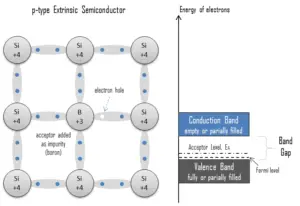 Electron-hole Pair. In the semiconductor,costless charge carriers areelectrons andelectron holes(electron-hole pairs). Electrons and holes are created byexcitation of electron from valence band to the conduction band. An electron hole (often simply called a pigsty) is the lack of an electron at a position where one could exist in an cantlet or atomic lattice. It is ane of the two types of accuse carriers that are responsible for creating current in semiconducting materials. Since in a normal atom or crystal lattice the negative charge of the electrons is balanced by the positive charge of the diminutive nuclei, the absenteeism of an electron leaves a net positive charge at the hole's location. Positively charged holes tin motility from cantlet to cantlet in semiconducting materials every bit electrons exit their positions. When an electron meets with a hole, they recombine and these free carriers finer vanish. The recombination means an electron which has been excited from the valence band to the conduction ring falls back to the empty state in the valence ring, known as the holes.
Electron-hole Pair. In the semiconductor,costless charge carriers areelectrons andelectron holes(electron-hole pairs). Electrons and holes are created byexcitation of electron from valence band to the conduction band. An electron hole (often simply called a pigsty) is the lack of an electron at a position where one could exist in an cantlet or atomic lattice. It is ane of the two types of accuse carriers that are responsible for creating current in semiconducting materials. Since in a normal atom or crystal lattice the negative charge of the electrons is balanced by the positive charge of the diminutive nuclei, the absenteeism of an electron leaves a net positive charge at the hole's location. Positively charged holes tin motility from cantlet to cantlet in semiconducting materials every bit electrons exit their positions. When an electron meets with a hole, they recombine and these free carriers finer vanish. The recombination means an electron which has been excited from the valence band to the conduction ring falls back to the empty state in the valence ring, known as the holes.
Copper – Crystal Structure
A possible crystal structure of Copper is face up-centered cubic structure.
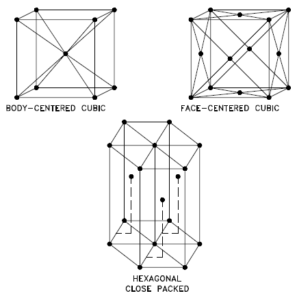
In metals, and in many other solids, the atoms are arranged in regular arrays chosen crystals. A crystal lattice is a repeating pattern of mathematical points that extends throughout infinite. The forces of chemical bonding causes this repetition. It is this repeated blueprint which control backdrop like forcefulness, ductility, density, conductivity (property of conducting or transmitting heat, electricity, etc.), and shape. There are 14 general types of such patterns known as Bravais lattices.
The three most common basic crystal patterns are:
- Trunk-centered Cubic. In a trunk-centered cubic (BCC) organisation of atoms, the unit cell consists of eight atoms at the corners of a cube and ane atom at the body centre of the cube. In a torso-centered cubic system, a unit cell contains (8 corner atoms × ⅛) + (1 eye atom × 1) = 2 atoms. The packing is more efficient (68%) than simple cubic and the construction is a common one for alkali metals and early on transition metals. Metals containing BCC structures include ferrite, chromium, vanadium, molybdenum, and tungsten. These metals possess loftier strength and low ductility.
- Confront-centered Cubic.In a face up-centered cubic (FCC) arrangement of atoms, the unit cell consists of eight atoms at the corners of a cube and one atom at the center of each of the faces of the cube. In a face-centered cubic arrangement, a unit cell contains (8 corner atoms × ⅛) + (6 face atoms × ½) = four atoms. This structure, along with its hexagonal relative (hcp), has the nigh efficient packing (74%). Metals containing FCC structures include austenite, aluminum, copper, lead, silver, gold, nickel, platinum, and thorium. These metals possess depression strength and high ductility.
- Hexagonal Close-packed. In a hexagonal close-packed (HCP) system of atoms, the unit prison cell consists of iii layers of atoms. The top and bottom layers contain six atoms at the corners of a hexagon and one atom at the heart of each hexagon. The heart layer contains iii atoms nestled between the atoms of the peak and bottom layers, hence, the proper name shut-packed. Hexagonal close packed (hcp) is one of the two simple types of atomic packing with the highest density, the other being the face up centered cubic (fcc). However, different the fcc, information technology is not a Bravais lattice as in that location are 2 nonequivalent sets of lattice points. Metals containing HCP structures include glucinium, magnesium, zinc, cadmium, cobalt, thallium, and zirconium. HCP metals are not as ductile as FCC metals.
–
Source: https://www.periodic-table.org/Copper-periodic-table/
Posted by: taylorcultin.blogspot.com

0 Response to "Does Copper Have The Smae Makeup As Gold"
Post a Comment